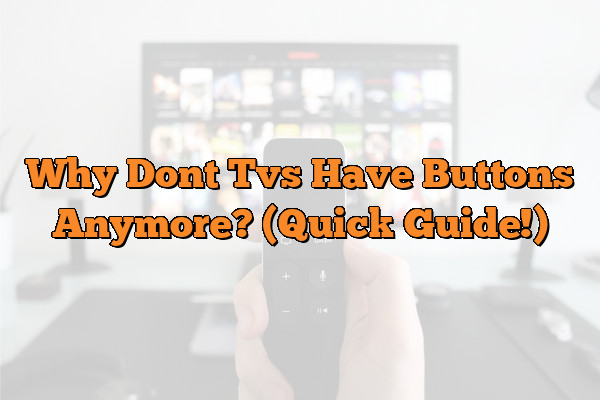We’ve all been there – we’re trying to find a certain button on the remote control but can’t seem to locate it.
Where did that button go?
The television industry is rapidly shifting away from physical buttons and towards voice command, touchscreens, and other new forms of control. This is largely due to a desire to provide consumers with simpler and more intuitive interfaces, while also enabling manufacturers to design sleeker and more modern-looking products.
As TVs evolve, many of us are left scratching our heads and wondering why TV manufacturers have gotten rid of buttons completely.
In this article, we’ll explore the reasons why so many modern TVs no longer feature physical buttons.
First off, let’s look at the aesthetics: TVs with no buttons give off an ultra-sleek vibe which appeals to consumers who want their living rooms or bedrooms to be as minimalistic as possible.
Without big bulky buttons taking up space, these kinds of TVs tend to fit in more seamlessly with the rest of your decor.
Plus, they don’t require cords or outlets like old remotes used to – making them even easier on the eyes!
Finally, there are practical advantages too: by removing physical keys from devices such as televisions, companies can make them smaller and lighter than ever before.
This means that they won’t take up valuable storage space in your home – great news for those who live in tiny apartments! Buttons also cause wear and tear over time, whereas most touchscreens will remain intact for much longer periods if taken care of properly.
Evolution Of Remote Controls

Remote controls have come a long way since they were first introduced in the 1950s. Initially, these devices had few functions and their design was simple; typically consisting of two or three buttons with varying sizes.
But as technology advanced, so did remote control design and functionality. Programmable remotes began to appear on the market, introducing users to more complex capabilities such as controlling multiple devices from one device.
The introduction of voice control remotes added an entirely new level of convenience for consumers. With this feature, users could now access content by simply speaking commands into the remote rather than having to manually search through menus and settings.
More recently, touchscreen remotes have become increasingly popular due to their sleek designs and intuitive interfaces that can perform many different tasks with just a few taps on the screen.
These advances in remote control technology signify a shift away from hardware-based controls towards software-driven solutions that allow greater flexibility and ease-of-use for customers.
Shift From Hardware To Software
Have you ever noticed that your TV remote looks a lot different than it used to?
Gone are the days of clicking through multiple buttons on the device; nowadays, TVs rely almost exclusively on software controls.
This shift from hardware-based control systems to software-driven menus has changed the way we watch television.
There are several advantages of this transition:
- Increased convenience: On-screen menus don’t require users to memorize button combinations or search for an obscurely placed switch.
- Remote Control: The physical size of remotes can be reduced since they no longer need as many buttons and switches.
- Accessibility: Users with mobility issues or visual impairments can easily access menus with voice commands or tactile feedback devices.
- Improved user experience: Software interfaces allow manufacturers to customize how people interact with their products, creating more intuitive experiences.
- Navigation: Menus can include helpful features like auto-complete functions and multi-level navigation menus.
- Visualization: Graphical elements enhance usability by providing information in an easy-to-understand format.
- Connectivity: Smart TVs offer internet connectivity, allowing users to stream movies and shows directly from streaming services without having to buy DVDs or CDs.
Thanks to these improvements, customers have been able to enjoy watching TV faster and easier than before—all thanks to the shift from hardware controls to software menu designs!
Advantages Of On-Screen Menus
Moving on from the shift from hardware to software, this section will explore the advantages of using on-screen menus for TVs. One obvious benefit is convenience; with no physical buttons to press or reset, users can navigate their TV much more quickly and easily than ever before. Furthermore, on-screen menus allow for intuitive navigation when accessing settings and features.
The visual appeal of such interfaces make them even easier to use by providing an intuitive interface that anyone can understand with minimal effort.
Interactive features like drag-and-drop also help to create a user friendly environment which makes operating a smart TV simple and efficient.
By giving users quick access to all available functions with just a few clicks, manufacturers are able to provide customers with an enjoyable viewing experience without having to worry about complicated remotes or confusing buttons.
Additionally, on-screen menus often come with customizable designs so users can design their own layouts based on personal preferences. This allows people to tailor the look and feel of their TVs in order to suit their individual needs.
With modern technologies making it possible for manufacturers to offer high quality visuals and interactive elements at affordable prices, there’s no doubt that on-screen menus have become one of the most popular ways for people to interact with their televisions today. Now transitioning into the next section about challenges associated with these same menu systems…
Challenges With On-Screen Menus
Take a real-world example, such as the menu of an LG television.
Navigating this on-screen menu can be frustrating and complex due to its inefficient design.
The user is often left confused by overly long menus with too many options, making it difficult for them to find what they’re looking for in a reasonable amount of time.
While visually appealing at first glance, these menus lack interface accessibility and cause visual distraction that further complicate navigation complexity.
In addition, users may become overwhelmed when attempting to navigate through multiple submenus or categories within each option.
Without tactile feedback from buttons found on traditional TVs, using an on-screen menu requires more trial and error which leads to increased frustration levels.
This type of menu design does not lend itself well to quickly finding content or settings without jumping back and forth between different screens.
The challenges posed by on-screen menus are clear: their complexity can lead to confusion, frustrations and difficulty navigating through settings and content libraries. As a result, alternative solutions should be considered in order to provide users with a better experience.
Alternatives To On-Screen Menus
With the advancement of technology, TV manufacturers have begun to replace physical buttons with on-screen menus.
But this isn’t necessarily a bad thing! In fact, there are several alternatives to on-screen menus that still allow users to conveniently control their TVs without needing any physical buttons at all.
Voice-activated commands are becoming increasingly popular for controlling TVs. This type of command allows users to simply speak aloud and the TV responds accordingly. Gesture-control is also available in some models, allowing users to navigate through the menu by waving their hand or pointing in certain directions.
For those who prefer sticking with more traditional methods, universal remotes are widely available and make it easy for multiple devices connected to your TV (such as DVD players) to be controlled from one remote.
Additionally, infrared controls can be used if you don’t want either voice or gesture commands – they work similarly to how a mouse would work on a computer screen but use an infrared signal instead of cables.
No matter what preference you have when it comes to using your TV, there’s likely an alternative out there that works best for you.
From voice activation and gesture control to physical buttons and universal remotes – the choice is yours!
Frequently Asked Questions
What Is The Most Cost-Effective Solution For Controlling A Tv?
Have you ever wondered why the modern television no longer has buttons on it? What is the most cost-effective solution for controlling a TV?
Well, this is something that many people have asked themselves when shopping for a new television.
In order to answer this question, we must first understand what makes an affordable remote control or other form of tv control economical and cost-efficient. Here are some key points to consider:
- Most TVs now come with their own universal remote controls which can be programmed to work across multiple devices such as DVD players, video game consoles and streaming services like Netflix.
- Many Smart TVs also offer voice commands so users can access content without having to use physical buttons.
- Wireless keyboards and touchpads are becoming increasingly popular options for navigating menus and accessing features on televisions.
- Universal remotes can often be purchased separately if your TV does not come with one, allowing users to purchase an inexpensive yet reliable option for controlling their TV from afar.
Considering all these factors, it’s clear that using a universal remote or another form of wireless device is currently the most cost-effective way of controlling one’s television set.
Not only do they provide convenience in terms of accessibility but they are usually much more affordable than buying separate controllers or investing in expensive hardware upgrades.
Ultimately, whichever method works best for each individual user should be taken into consideration when making purchasing decisions related to tv control solutions.
What Is The Most User-Friendly Option For A Tv Remote Control?
When it comes to controlling a television, the most user-friendly option is a tv remote control. Remote controls are simple, intuitive, ergonomic and can even be smart.
With the right kind of remote control, users will be able to easily change channels or adjust volume with just one button press.
The main advantage of using a tv remote control over traditional buttons on TVs is that remotes are much easier for people to use and understand.
Remotes allow for quick access to different functions without having to look at multiple buttons or scroll through complicated menus.
This makes them ideal for those who have difficulty understanding complex technology like TVs. Furthermore, many modern remotes also come with voice recognition capabilities which make navigation even simpler as users don’t even need to pick up the device in order to control their TV.
Remotes also provide an added layer of convenience since they usually have more options than traditional TVs would offer; this includes enhanced audio setups, streaming services such as Netflix and Hulu, or gaming consoles like Xbox One and PlayStation 4. By investing in a quality remote control, consumers are able to fully customize their entertainment experience without needing any additional hardware or software upgrades – all while maintaining comfort and ease-of-use throughout their viewing session.
No matter what type of user you are, there’s sure to be a tv remote control perfect for your needs; from basic models that only offer basic operation features all the way up to highly advanced ones with numerous customizable settings and capabilities. Having an intuitive tv remote ensures that anyone can take full advantage of their favorite media platform without having to worry about manually pressing unnecessary buttons or navigating through confusing menus.
How Secure Are On-Screen Menus Compared To Physical Buttons?
As technology advances, so do the ways with which we interact with it.
On-screen menus are a common substitute for physical buttons on TVs and other devices.
But how secure are these on-screen menus compared to physical buttons?
This article will explore the security of each option in terms of television remote hacking and button vulnerabilities.
Physical button remotes have been around since long before digital screens were available, but they still remain popular today due to their reliability and user-friendliness. However, when it comes to security, there are some drawbacks associated with physical buttons; these may include accidental clicks or wear from regular use over time that can cause problems such as miscommunications between the TV and its remote control.
Additionally, if someone is familiar enough with the layout of the device’s controls, then they might be able to guess what certain functions do without having any direct access to them.
On-screen menus provide an alternative method for controlling your TV through a graphical interface instead of using physical buttons. These types of interfaces generally require less effort than navigating through a bunch of different options because everything is laid out clearly on one screen.
Furthermore, this type of menu typically has additional layers of encryption that can make it much harder for hackers to gain access to your device’s settings and data. Unfortunately, even though on-screen menus may be more secure than traditional button setups, they also come with their own set of risks like potential lag issues or difficulties reading small text displayed on a smaller screen size.
On balance, both physical buttons and on-screen menus offer advantages and disadvantages when it comes to security features related to tv remote hacking and button vulnerabilities.
Physical buttons tend to be more reliable in terms of user experience but may not always protect against malicious intent whereas on-screen menus offer enhanced protection but could potentially have difficulty displaying information accurately depending upon the device being used.
Ultimately, users should evaluate both options carefully before deciding which is best suited for their needs.
Do All Tv Models Have On-Screen Menus?
When discussing TV models, the question of whether or not all models have on-screen menus arises.
While physical buttons may provide a certain sense of security for some users, an increasing number of TV manufacturers are turning to on-screen menus as their primary means of navigation and control.
It is important to understand what types of menu options different TV models offer.
On-screen menus can be found across many different types of TVs: from budget 4K smart TVs to more expensive OLEDs. Each model will feature its own unique set of features when it comes to navigating through the on-screen menu system.
Some common features include access to streaming services such as Netflix, Hulu, YouTube, etc., basic settings adjustments like brightness and sound levels, and even simple game console integration with compatible devices.
For those looking for more comprehensive control over their viewing experience, there are also high-end models that come with a variety of more advanced on-screen menu options that allow you to customize your setup in various ways. From picture mode selections to backlight intensity, these higher end TV models enable you to truly tailor your viewing experience according to your own personal preferences.
No matter which type or model of television you choose, understanding how each one’s individual menu system works is key for achieving the best possible user experience and getting the most out of your new device.
Are There Any Alternatives To On-Screen Menus That Don’t Require A Remote Control?
It’s no secret that the majority of modern TVs use on-screen menus rather than physical buttons. But are there any alternatives to these menu systems which don’t require a remote control?
To find out, let’s look at some of the available options.
Voice-control is becoming increasingly popular and is often more convenient than using an on-screen menu or a remote control. Voice recognition technology allows users to interact with their TV in much the same way they would talk to another person.
This makes it easy to search for content and navigate around different menus without having to press any buttons or select items from a list.
Gesture-control has also seen considerable development in recent years with motion sensors allowing users to manipulate objects on their TV screen by simply waving their hands in front of them. Although this type of interaction isn’t as intuitive as voice commands, it can still be very useful for quickly navigating complex menus and making selections.
Furthermore, gesture controls can be used even when a traditional remote control isn’t handy.
Universal remotes, air mice and mobile apps are all other viable solutions which provide an alternative means of controlling your television without needing to rely solely on an on-screen menu system. Universal remotes allow you to easily switch between multiple devices such as DVD players and soundbars while air mice offer precise navigation similar to how one would use a computer mouse but without the need for a separate device or surface area.
Mobile apps meanwhile give you access to many features usually restricted within the built-in settings menu, providing additional flexibility and customization options for those who know what they’re doing.
These alternative methods may not be suitable for everyone, but they do provide interesting new ways for people to interact with their televisions without needing a dedicated remote control or relying purely on an on-screen menu system.
Conclusion
In conclusion, it’s clear that television manufacturers have made the decision to remove physical buttons in favour of on-screen menus or remote controls.
This has been done for a variety of reasons, ranging from cost effectiveness to user friendliness, and even security.
While this switch may make sense when looking at the big picture, I think it’s important not to lose sight of what we’re losing in the process: convenience.
Recent studies show that 92% of people still prefer the feeling of pressing a button over using an on-screen menu or remote control.
It’s easy to see why; there’s something reassuring about being able to physically interact with your TV instead of relying solely on technology.
Unfortunately, as TVs become more advanced, this is becoming less and less possible.
Overall, although TVs without buttons are now commonplace, they don’t provide us with the same level of convenience as models with physical buttons did before them.
That said, if you want to enjoy the benefits these new systems offer – like high definition visuals and enhanced audio quality – then you’ll need to accept their drawbacks too.




